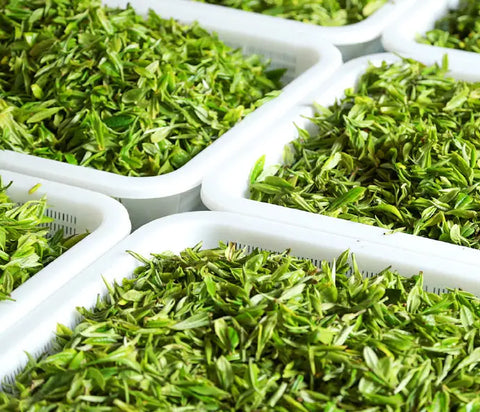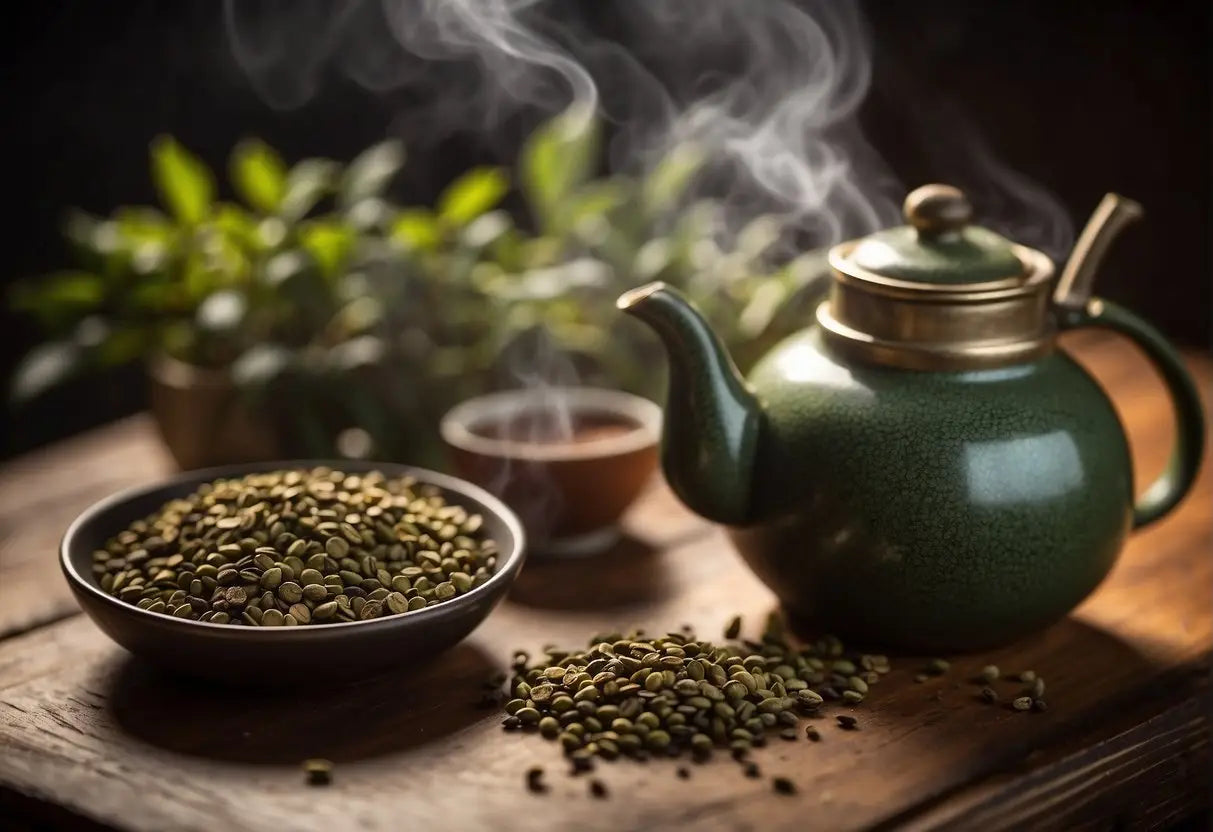What Tea Has the Most Caffeine
Shop our Pu Erh Tea collections!
Caffeine content in tea can vary widely depending on the type of tea leaf, its processing, and brewing methods. Generally, black tea has the highest caffeine content, followed by oolong tea, green tea, and then white tea. Here's a quick guide to the average caffeine content in tea:
| Tea Type | Average Caffeine Content per 8 oz |
|---|---|
| Black Tea | 60-90 mg |
| Oolong Tea | 50-75 mg |
| Green Tea | 30-50 mg |
| White Tea | 15-30 mg |
| Herbal Tea* | 0 mg |
*Herbal teas generally contain no caffeine unless blended with tea leaves.
Bestsellers
Discover our best-selling raw Pu Erh tea and elevate your tea experience today!
When you brew your tea, several factors affect the caffeine level. Longer brewing times and hotter water temperatures usually increase the caffeine content in your cup. For example, steeping your black tea for 3 minutes could yield approximately 40-70 mg of caffeine, whereas a 5-minute steep could increase that to 60-90 mg.
It's important to note that these figures are average estimates and actual caffeine content can vary. The same tea plant (Camellia sinensis) is the source of black, green, white, and oolong teas, but differences arise during processing. Black tea is fully oxidized, accounting for its higher caffeine content. Green and white teas are less oxidized, resulting in lower caffeine levels.
In comparison, tea generally has less caffeine than coffee, which can contain 95-200 mg per 8 oz cup. If you're sensitive to caffeine or looking to reduce intake, opt for white or herbal teas.
Types of Tea and Caffeine Content

The caffeine content in tea varies depending on the type and processing of the leaves. Knowing the caffeine levels can help you make an informed choice for your tea selection.
Black Tea
Black tea is typically the highest in caffeine, containing between 40-70mg per 8 oz cup. This is due to the full oxidation process the leaves undergo, which also contributes to its robust flavor and darker color.
Oolong Tea
Oolong tea offers a moderate caffeine level, usually around 30-50mg per 8 oz cup. The partial oxidation of oolong tea strikes a balance between black and green tea, both in flavor and caffeine content.
Green Tea
Green tea has a lower caffeine content than black tea, generally ranging from 20-45mg per 8 oz cup. The minimal processing retains the green color and lighter taste, along with a moderate amount of caffeine.
White Tea
White tea is the least processed of all teas and generally contains 15-30mg of caffeine per 8 oz cup. This tea is delicate in flavor and has lower caffeine content, making it a subtle pick-me-up.
Pu-Erh Tea
Pu-erh tea is a type of fermented tea with a caffeine content similar to black tea, around 30-70mg per 8 oz cup. It's unique in that it can be aged, which can influence its flavor and caffeine levels.
Matcha
Matcha is a powdered green tea and provides a higher caffeine content, often 70-80mg per 8 oz cup. Since you consume the whole leaf in powdered form, you ingest more caffeine compared to other types of green tea.
Lao Ban Zhang
Factors Affecting Caffeine Levels
The caffeine content in tea is influenced by various elements, from the plant's growth to its brewing. Understanding these factors can help you select a tea with the desired level of caffeine.
Cultivation Conditions
- Geographical Location: The region where tea is grown can impact caffeine levels. For example, tea plants from East Africa often have higher caffeine compared to those from South Asia due to higher elevations and more intense sunlight.
- Soil Chemistry and Climate: Nutrient-rich soil and climates with significant temperature variations can lead to increased caffeine in tea leaves.
Processing Methods
- Type of Tea: Black teas generally undergo full oxidation, leading to higher caffeine concentrations. In contrast, green and white teas are less oxidized, typically containing less caffeine.
- Rolling and Crushing: These techniques can disrupt cell structures within the leaf, which may result in more caffeine being extracted during brewing.
Brewing Techniques
- Water Temperature: Using boiling water or very hot water can extract caffeine more effectively than water at lower temperatures.
- Steeping Time: The longer you steep your tea, the more caffeine it will likely contain; a quick dip results in less caffeine, whereas a few minutes can increase the amount significantly.
- Leaf Size: Finely cut leaves have a larger surface area allowing for quicker and more complete caffeine extraction compared to whole leaves.
Comparing Tea to Other Caffeinated Drinks

When considering your options for a caffeinated beverage, it's important to understand how tea stacks up against other common choices like coffee, energy drinks, and soft drinks.
Coffee
Coffee is widely recognized for its high caffeine content. On average, an 8-ounce cup of coffee contains approximately 95 mg of caffeine. Variations in coffee type, brewing method, and serving size can cause this number to range significantly.
Energy Drinks
Energy drinks can vary widely in caffeine content, generally ranging from 50 mg to a potent 300 mg per serving. They may also contain additional stimulants and supplements aimed at boosting energy levels, which can influence their overall stimulating effects.
Soft Drinks
Soft drinks typically have less caffeine compared to tea, often ranging from 20 to 40 mg per 12-ounce serving. However, caffeine-free options are also readily available for those looking to avoid the stimulant entirely.
Health Considerations of Caffeine Consumption

Caffeine affects your body's central nervous system and can have both positive and negative health implications that are important to understand.
Benefits
Moderate caffeine consumption has been associated with certain health benefits.
- Alertness: It can temporarily provide a sharpened mental focus and combat drowsiness.
- Physical Performance: Some studies suggest an improvement in physical performance and reduced perception of effort.
Risks
However, excessive caffeine intake can lead to health risks.
- Insomnia: It can disrupt sleep patterns, leading to insufficient rest.
- Anxiety: High doses might increase feelings of anxiety and nervousness.
Daily Limits
To minimize risks, staying within recommended daily limits is important.
Adults:
- Up to 400 milligrams of caffeine per day appears to be safe for most healthy adults.
- This is roughly the amount of caffeine in four cups of brewed coffee.
Pregnant People:
- Should limit intake to less than 200 milligrams per day due to potential effects on fetus development.
Methods to Reduce Caffeine in Tea
When you want to enjoy tea with less caffeine, there are several methods you can employ to achieve this. Being mindful of these techniques can enhance your tea-drinking experience while keeping caffeine intake in check.
Shorten the Steeping Time: The longer you steep tea, the more caffeine is released. Aim to steep your tea for a shorter duration than usual; try halving the time.
- Initial Steeping: 30 seconds to 1 minute
- Usual Steeping: 1 to 5 minutes
Lower the Water Temperature: Hotter water extracts caffeine more efficiently. By using water that is not at boiling point, you can reduce the amount of caffeine infused in your brew.
- Green Tea: 150-180°F (65-82°C)
- Black Tea: 180-200°F (82-93°C)
Choose Larger Leaf Grades or Whole Leaf Teas: The smaller the leaf size, the quicker the caffeine release. Opt for whole leaf teas or larger leaf grades to slow down the extraction of caffeine.
Tea Leaf Grades:
- CTC (Crush, Tear, Curl – higher caffeine)
- Orthodox (Whole leaves – lower caffeine)
Decaffeinate at Home: You can remove some caffeine yourself by quickly rinsing the tea leaves with hot water for about 30 seconds and then discarding this water. Follow with a fresh steep using the same leaves.
Select Low-Caffeine Varieties: Start with teas that are naturally lower in caffeine, such as white or decaffeinated teas.
Common Low-Caffeine Teas:
- White Tea
- Decaffeinated Tea
Remember, these methods won't eliminate caffeine completely but will help in reducing its level in your cup of tea.
Frequently Asked Questions
When exploring the world of tea and caffeine, your main concerns likely revolve around identifying the teas with the most caffeine and understanding how they compare to other caffeinated beverages. This section addresses those queries with specific details.
Which types of tea contain the highest levels of caffeine?
The teas with the highest caffeine content are typically black and pu-erh teas. Factors such as the processing method and the maturity of the leaves at harvest contribute to their caffeine levels.
How do caffeine levels in black tea compare to other teas?
Black tea generally contains more caffeine than other teas, with typical levels ranging from 40 to 70 milligrams per 8-ounce serving. Green tea follows, then white tea, with lower caffeine contents.
Are there specific tea brands known for their high caffeine content?
Brands like Zest Tea and The Republic of Tea offer high caffeine tea blends designed to provide an energy boost, often reaching levels comparable to coffee.
What are the caffeine differences between tea and coffee?
Coffee usually contains significantly more caffeine, with an average of 95 milligrams per 8-ounce cup compared to the 15-70 milligrams found in tea, depending on the variety.
Which tea at Starbucks offers the highest caffeine punch?
The Starbucks Chai Latte contains the most caffeine among its tea selections, typically higher than their green or herbal teas.
Which tea provides the most energy based on its caffeine levels?
Black tea often provides a robust energy lift due to its higher caffeine content. For a sustained energy boost, matcha is a good choice as it contains both caffeine and L-theanine, which promotes alertness without the jitters.
← Older post Newer post →











